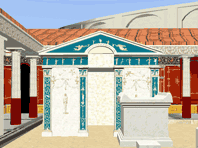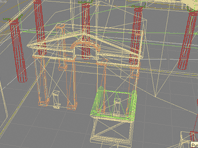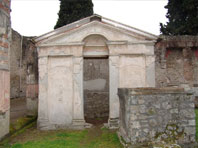Project History, Exhibits & Publications
Project History
The 3D models, sounds, scripts, and images were originally produced for the Pompeii Project at Carnegie Mellon's Studio for Creative Inquiry in 1995/96. The results are intended for use in a SGI/Irix computing environment. Carnegie Mellon University, the Archaeological Institute of America, Silicon Graphics, and other donors sponsored the project. (See credits.) PublicVR, a nonprofit group dedicated to free Virtual Reality software for arts and education, sponsored the Virtual Theater District (VRML)'s conversion to VRML format and certain improvements to the artwork. PublicVR currently handles distribution of all these materials. For more information contact Jeffrey Jacobson at jeff@publicvr.org.
Exhibits
The original "Virtual Pompeii" showed at the DeYoung Museum in 1995/96. The theater district was displayed on a large screen for an audience, while a trained tour guide navigated through the virtual space giving explanations and answering questions as s/he went. One patron got to see the virtual space through a Head-Mounted Display (HMD). San Francisco, California, USA, October 1995-January 1996.
The current version of the Virtual Theater District (VRML) is presently showing at the Gulf Coast Explorium in Mobile, Alabama. There, the audience also receives an interactive tour of the virtual space, which they view on a very large (120-degrees) curved screen. This is part of a larger exhibit on Pompeii. Mobile, Alabama, USA, January-June 2007.
Publications
Jacobson, J., Vadnal, J. (2005p) The Virtual Pompeii Project. World Conference on E-Learning in Corporate, Government, Healthcare, and Higher Education (E-Learn) Vancouver, Candada, October 24-28. PDF



